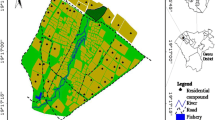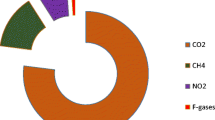Abstract
Nitrous oxide emissions, nitrate, water-soluble carbon and biological O2 demand (BOD5) were quantified in different crop** systems fertilized with varying amounts of nitrogen (clayey loam, October 1991 to May 1992), in an aerated tank (March 1993 to March 1994), and in the nitrification-denitrification unit (March to July 1994) of a municipal waste water treatment plant. In addition, the N2O present in the soil body at different depths was determined (February to July 1994). N2O was emitted by all crop** systems (mean releases 0.13–0.35 mg N2O m-2 h-1), and all the units of the domestic waste water treatment plant (aerated tank 0–6.2 mg N2O m-2 h-1, nitrification tank 0–204,3 mg N2O m-2, h-1, denitrifying unit 0–2.2 mg N2O m-2 h-1). During the N2O-sampling periods estimated amounts of 0.9, 1.5, 2.4 and 1.4 kg N2O−N ha-1, respectively, were released by the crop** systems. The aerated, nitrifying and denitrifying tanks of the municipal waste water treatment plant released mean amounts of 9.1, 71.6 and 1.8 g N2O−N m-2, respectively, during the sampling periods.
The N2O emission were significantly positively correlated with nitrate concentrations in the field plots which received no N fertilizer and with the nitrogen content of the aerated sludge tank that received almost exclusively N in the form of NH +4 . Available carbon, in contrast, was significantly negatively correlated with the N2O emitted in the soil fertilized with 80 kg N ha-1 year. The significant negative correlation between the emitted N2O and the carbon to nitrate ratio indicates that the lower the carbon to nitrate ratio the higher the amount of N2O released. Increasing N2O emissions seem to occur at electron donorto-acceptor ratios (CH2O or BOD5-to-nitrate ratios) below 50 in the crop** systems and below 1200–1400 in the waste water treatment plant. The trapped N2O in the soil body down to a depth of 90 cm demonstrates that agricultural production systems seem to contain a considerable pool of N2O which may be reduced to N2 on its way to the atmosphere, which may be transported to other environments or which may be released at sometime in the future.
Similar content being viewed by others
References
Abou-Seada MNI, Ottow JCG (1985) Effect of increasing oxygen concentration on total denitrification and nitrous oxide release from soil by different bacteria. Biol Fertil Soils 1:31–38
Benckiser G (1994) Relationships between field-measured denitrification losses, CO2 formation and diffusional constraints. Soil Biol Biochem 26:891–899
Benckiser G, Simarmata T (1994) Environmental impact of fertilizing soils by using sewage and animal wastes. Fert Res 37:1–22
Benckiser G, Syring KM, Gaus G, Haider K, Sauerbeck D (1987) Denitrification losses from an Inceptisol field treated with mineral fertilizer or sewage sludge. Z Pflanzenernaehr Bodenkd 150:241–248
Benckiser G, Lorch HJ, Ottow JCG (1995) Quantification of total denitrification losses from undisturbed field soils by the acetylene inhibition technique. In: Alef K, Nannipieri P (eds) Methods in applied microbiology and biochemistry. Academic Press, London, pp 473–478
Blackmer AM, Bremner JM, Schmidt EL (1980) Production of nitrous oxide by ammonium-oxidizing chemoautotrophic microorganisms in soil. Appl Environ Microbiol 40:1060–1064
Bock E, Widerer PA, Freitag A (1988) Growth of Nitrobacter in the absence of dissolved oxygen. Water Res 22:245–250
Bock E, Schmidt I, Stüven R, Zart D (1995) Nitrogen loss caused by denitrifying Nitrosomonas cells using ammonium or hydrogen as electron donors and nitrite as electron acceptors. Arch Microbiol 163:16–20
Burford JR, Bremner JM (1975) Relationship between the denitrification capacities of soils and total water-soluble readily decomposable soil organic matter. Soil Biol Biochem 7:389–394
Chalamet A (1990) Source and sink mechanisms related to denitrification measurement. Mittlgn Dtsch Bodenkdl Gesellsch 60:65–72
Davidson EA (1991) Fluxes of nitrous oxide from terrestrial ecosystems. In: Rogers JE, Whitman WB (eds) Microbial production and consumption of greenhouse gases; methane, nitrous oxides and halomethanes. Am Soc Microbiol, Washington, DC, pp 219–235
Dritter Bericht der Enquete-Kommission (1994) Schutz der Erdatmosphäre, Econimica Verlag, DS 12/8350, Sachgebiet 2129, pp 71–88
Hazzard JH, Gorga JC, Gaughey WS (1985) Determination of anesthetic molecule environments by infrared spectroscopy. II Multiple sites for nitrous oxide in proteins, lipids and brain tissue. Arch Biochem Biophys 240:747–756
Hooper AB, Arciero DM, DiSpirito AA, Fuchs J, Johnson M, LaQuier F, Mundfrom G, McTavish H (1990) Production of nitrite and N2O by the ammonia-oxidizing nitrifiers. In: Gresshoff PM, Roth LE, Stacey G, Newton WE (eds) Nitrogen fixation: Achievements and Objectives. Chapman and Hall, New York, pp 387–392
Kemper WD, Rosenau R, Nelson S (1985) Gas displacement and aggregate stability of soils. Soil Sci Soc Am J 49:25–28
Körner R, Benckiser G, Ottow JCG (1993) Quantifizierung der Lachgas (N2O)-Freisetzung aus Kläranlagen unterschiedlicher Verfahrensführung. Korres Abwasser 40:514–525
Lehn-Reiser M, Benckiser G, Ottow JCG (1991) Mikrobielle Aktivität Dimethylsulfoxid-Reduktaseaktivität, aktuelle und potentielle Denitrifikationskapazität, BSB5 der Dränzone landwirtschaftlich genutzter Böden im Wassereinzugsgebiet Süchteln. Mittlgn Dtsch Bodenkundl Gesellsch 66:555–558
Linn A, Benckiser G, Ottow JCG (1995) In situ-Quantifizierung der N2O-Freisetzung aus den Nitrifikations- und Denitrifikationsbecken der Kläranlage Gießen in Abhängigkeit von den chemischphysikalischen Abwassereigenschaftren VDLUFA Schriftr 39: 595–598
Lorch H-J (1993) Mikrobiologische Charakterisierung und Stoffumsatz der einzelnen Reinigungsstufen verschiedener belüfteter Abwasserteichanlagen im ländlichen Raum. Habilitationsschrift, Justus-Liebig University Gießen
Martikainen PJ, De Boer W (1993) Nitrous oxide production and nitrification in an acidic soil from a Dutch coniferous forest. Soil Biol Biochem 25:343–347
Minami K (1987) Emission of nitrous oxide (N2O) dissolved in drainage water from agroecosystems. J Agr Res Quat 21:22–27
Moraghan JG, Buresh RJ (1977) Correction for dissolved nitrous oxide in nitrogen studies. Soil Sci Soc Am J 41:1201–1203
Mosier AR, Schimel DS (1993) Nitrification and denitrification. In: Knowles R, Blackburn TH (eds) Nitrogen isotope techniques. Academic Press, London, pp 181–208
Myrold DD, Tiedje JM (1985) Establishment of denitrification capacity in soil: Effects of carbon, nitrate and moisture content. Soil Biol Biochem 17:819–822
Navone R (1964) Proposed method for nitrate in potable waters. J Am Water Works Assoc 56:781–783
Ottow JCG (1992) Denitrifikation, eine kalkulierbare Größe in der Stickstoffbilanz von Böden? Wasser und Boden 9:578–581
Ottow JCG, Glathe H (1973) Pedochemie und Pedomikrobiologie hydromorpher Böden: Merkmale, Voraussetzungen und Ursachen der Eisenreduktion. Chem Erde 32:1–44
Ottow JCG, Benckiser G (1994) Effect of ecological conditions on total denitrification and N2O release from soils. Nova Acta Leopoldina 288:251–262
Papen H, Seiler W (1994) Treibhauseffect, der Beitrag der Landwirtschaft. Praxis Naturw Biol 43:17–21
Robertson LA, Kuenen JG (1991) Physiology of nitrifying and denitrifying bacteria. In: Rogers JE, Whiteman WP (eds) Microbial production and consumption of greenhouse gases: Methane, nitrogen oxides and halomethanes. Am Soc Microbiol, Washington DC, pp 189–199
Ronen D, Magaritz M, Almon E (1988) Contaminated aquifiers are a forgotten component of the global N2O budget. Nature (London) 335:57–59
Scharpf HC, Wehrmann J (1976) Die Bedeutung des Mineralstick-stoffvorrates des Bodens zu Vegetationsbeginn für die Bemessung der N-Düngung zu Winterweizen. Landwirtsch Forsch 32:100–114
Schwarz J, Kapp M, Benckiser G, Ottow JCG (1994) Evaluation of denitrification losses by the acetylene inhibition technique in a permanent ryegrass field (Lolium perenne) fertilized with animal slurry or ammonium nitrate. Biol Fertil Soils 18:327–333
Simarmata T, Benckiser G, Ottow JCG (1993) Effect of an increasing carbon:nitrate-N ratio on the reliability of acetylene in blocking the N2O-reductase activity of denitrifying bacteria in soil. Biol Fertil Soils 15:107–112
Sümer E, Weiske A, Benckiser G, Ottow JCG (1995) Influence of environmental conditions on the amount of N2O released from activated sludge in a domestic waste water treatment plant. Experentia 51:419–422
Sümer E, Benckiser G, Ottow JCG (1996) Lachgas (N2O)-Freisetzung aus Belebungsbecken von Kläranlagen in Abhängigkeit von den Abwassereigenschaften. In: Lemmer H, Griebe T, Flemming HC (eds) Mikrobielle Ökologie des Abwassers. Springer, Berlin Heidelberg New York, pp 193–204
Tiedje JM (1988) Ecology of denitrification and dissimilatory nitrate reduction to ammonium. In: Zehnder AJB (ed) Biology of anaerobic microorganisms. John Wiley and Sons, New York, pp 179–244
Tortoso AC, Hutchinson GL (1990) Contribution of autotrophic and heterotrophic nitrifiers to soil NO and N2O emissions. Appl Environ Microbiol 56:1799–1805
Weiske A, Benckiser G, Ottow JCG (1995) Quantifizierung von gelöstem Lachgas (N2O) in Abwasser, Böden und Kompost. VDLUFA Schriftr 39:623–626
Wicht H, Beier M (1995) N2O-Emissionen aus nitrifizierenden und denitrifizierenden Kläranlagen. Korres Abwasser 42:405–413
Author information
Authors and Affiliations
Additional information
Dedicated to Professor J.C.G. Ottow on the occasion of his 60th birthday
Rights and permissions
About this article
Cite this article
Benckiser, G., Eilts, R., Linn, A. et al. N2O emissions from different crop** systems and from aerated, nitrifying and denitrifying tanks of a municipal waste water treatment plant. Biol Fertil Soils 23, 257–265 (1996). https://doi.org/10.1007/BF00335953
Received:
Issue Date:
DOI: https://doi.org/10.1007/BF00335953




